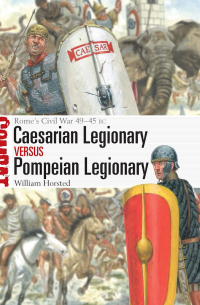William Horsted — новинки
-
Caesarian Legionary vs Pompeian Legionary. Rome’s Civil War 49–45 BC William Horsted
ISBN: 9781472867049 Год издания: 2025 Издательство: Osprey Publishing Язык: Английский A fully illustrated study of the troops fighting for Caesar and Pompey in three major battles of the Roman Civil War.
Triggered by the tensions surrounding Julius Caesar's return to Rome from Gaul, the civil war that broke out in 49 BC convulsed the Roman world. Commanders and troops loyal to Gnaeus Pompeius Magnus, known as Pompey, confronted those following Caesar in a series of brutal battles across the Mediterranean, from Hispania to Greece.
William Horsted assesses the similarities and differences between the evolving Caesarian and Pompeian armies, which included not only Roman legions but also auxiliaries from Gaul, Numidia and elsewhere. Even after Pompey's defeat at Pharsalus (48 BC) and his subsequent death in Egypt, the conflict continued, with Pompey's relatives and followers continuing the fight until 45 BC. The two armies are examined in the context of three major clashes of the conflict: Dyrrachium (48 BC) in present-day Albania; Thapsus (46 BC) in modern Tunisia; and Munda (45 BC) in Spain. The text is complemented by specially commissioned colour artwork and mapping as well as archive photographs. -
British Celtic Warrior vs Roman Soldier: Britannia AD 43–105 William Horsted
ISBN: 9781472850898 Год издания: 2022 Издательство: Osprey Publishing An illustrated study of the British tribal warriors and Roman auxiliaries who fought in three epic battles for control of Britain in the 1st century AD.
Following the Roman invasion of Britain in AD 43, the tribes of the west and north resisted the establishment of a ‘Roman peace', led in particular by the chieftain Caratacus. Even in the south-east, resentment of Roman occupation remained, exploding into the revolt of Boudicca's Iceni in AD 60. Roman auxiliaries from two particular peoples are known to have taken part in the invasion of Britain: the Tungrians, from what is now Belgium, and the Batavians, from the delta of the River Rhine in the modern Netherlands. From the late 80s AD, units of both the Batavians and the Tungrians were garrisoned at a fort at Vindolanda in northern Britain. The so called ‘Vindolanda tablets' provide an unparalleled body of material with which to reconstruct the lives of these auxiliary soldiers in Britain.
Featuring full-colour maps and specially commissioned battlescene and figure artwork plates, this book examines how both the British warriors and the Roman auxiliaries experienced the decades of conflict that followed the invasion. Their recruitment, training, leadership, motivation, culture and beliefs are compared alongside an assessment of three particular battles: the final defeat of Caratacus in the hills of Wales in AD 50; the Roman assault on the island of Mona (Anglesey) in AD 60; and the battle of Mons Graupius in Scotland in AD 83. -
The Numidians 300 BC–AD 300 William Horsted
ISBN: 9781472842190 Год издания: 2021 Издательство: Osprey Publishing The Numidian light cavalry were among the best-known horsemen in the ancient world: riding without saddles or bridle, carrying only hide shields for defense and clutching a handful of light javelins, they were renowned for their darting attacks, swift retreats, and skirmishing prowess. Yet, as much as they were respected by their allies and enemies, they were unfairly derided for their indiscipline, their perceived lack of culture, and their fecklessness, and dismissed as uncivilized, nomadic barbarians from beyond the fringes of the cultured, settled Mediterranean world. The famous portrayal of Numidian horsemen on Trajan's Column, of barefoot riders in simple tunics, astride tiny ponies, reinforces this view, and is the image that is almost universally reproduced.
Recent scholarship, however, has shown that there is far more evidence for the armour and equipment of the Numidians than hitherto assumed. The carved stone shields and cuirasses that punctuate the decorative friezes of the stone ‘altars' at Kbor Klib and Chimtou in North Africa are confident representations of Numidian panoplies, not captured Carthaginian armour as has previously been argued. In this book, this research is presented alongside a close examination of various ancient texts which reveals that the Numidians also fielded infantry, slingers, archers, and even war elephants in conflicts across the Mediterranean, including Spain, Greece, northern Italy, and Thrace. All of these troops are brought to life in original colour artwork, complemented by chapters on their weapons and equipment, history, tactics, and organization.



